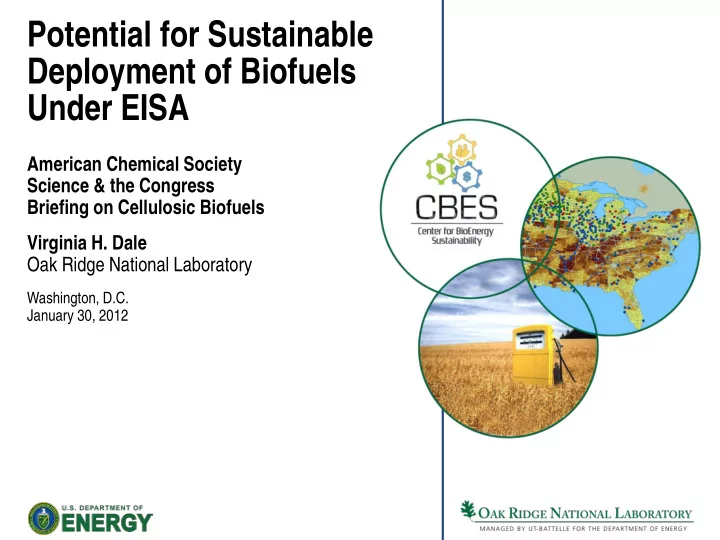

Potential for Sustainable Deployment of Biofuels Under EISA American Chemical Society Science & the Congress Briefing on Cellulosic Biofuels Virginia H. Dale Oak Ridge National Laboratory Washington, D.C. January 30, 2012
Looking at the biofuel supply chain in terms of sustainability indicators Feedstock Feedstock Conversion to Biofuel Biofuel logistics production logistics biofuel End uses Harvesting Conversion Engine type Land conditions Transport and collection process and efficiency Feedstock type Processing Fuel type Storage Blend conditions Management Storage Co-products Transport Environmental Socioeconomic Soil quality Profitability Water Social well being Greenhouse gases External trade Biodiversity Energy security Air quality Resource conservation Based on McBride et al. (2011) Productivity Social acceptability and Dale et al. (in review) Categories without major effects 2 Managed by UT-Battelle for the U.S. Department of Energy
Ready access to biomass sugars can reduce cost of processing cellulosic biomass Approach Outcomes to date Field trials of modified • Develop modified or natural biomass • Modified switchgrass at Ceres facility that is designed to release sugars biomass: more easily Switchgrass – Yields 30% • Engineer microbes to consolidate multiple more biofuel costly processes into a single step – Requires less commercial Recalcitrance: enzyme Resistance to – Now in commercial field trials breakdown • Improved yeast: into sugars Fuel(s) – Combines ability to digest cellulose and ferment – Now the basis of a commercial plant Prognosis: Needed technology improvements will impact industry Sugars within the next 5 years Cellulosic biomass Source: U.S. Department of Energy BioEnergy Science Center (http://bioenergycenter.org) 3 Managed by UT-Battelle for the U.S. Department of Energy
Evaluate land-use effects based on empirical evidence Land use is dynamic and bioenergy No empirical evidence for land-use contributes to ongoing land-use change changes due to bioenergy Initial change drivers (cultural, technical, 170 biophysical, political, economic, demographic) 160 Area (Mha) Initial land-use change 150 Subsequent 140 Ongoing land-use changes change drivers 130 Filters: Land-cover data, 120 scale, sources Cultivated Range land Forest land crop land Land cover (typically measured by remote sensing methods at one place and time) 1982 1987 1992 1997 2002 2007 60 Filters: Private land, rents Area (Mha) 40 Demand Global economic models 20 Prices, quantities, and distribution of goods 0 Filters: Land-cover, Non CRP Pasture Developed carbon change data cultivated land land land crop land Carbon stocks Source: CBES 2010 Based on data from USDA 2009-NRI (Dale et (http://www.ornl.gov/sci/besd/cbes/) al. 2011), supported by recent USDA reports
Compare bioenergy 1. Establish fuel sources 2. Obtain raw material to other energy alternatives 3. Distribute raw material 4. Produce fuel Environmental effects associated Projected environmental effects with gasoline production of ethanol production 1. Establish biomass 4. Produce feedstock biofuel 100,000 2. Extract oil 4. Produce Temporal scale (days) gasoline 3. Distribute 1,000 biomass 3. Distribute crude oil 2. Harvest 1. Explore for oil and collect biomass 10 0.1 100 1,000,000 100 1,000,000 0.01 0.01 Field Region Globe Field Region Spatial scale (km 2 ) Spatial scale (km 2 ) Stommel diagrams show spatial extent and duration of effects (Parish et al., in prep) 5 Managed by UT-Battelle for the U.S. Department of Energy
Adopt landscape perspective Consider fuel production within entire system (interactions and feedbacks) as an opportunity to design landscapes that add value Dale et al. (2010) 6 Managed by UT-Battelle for the U.S. Department of Energy
An optimization model can identify “ideal” sustainability conditions Spatial optimization model • Identifies where to locate plantings of bioenergy crops given feedstock needs for Vonore refinery • Considering – Farm profit – Water quality constraints Parish et al., Biofuels, Bioprod. Bioref . 6,58–72 (2012) 7 Managed by UT-Battelle for the U.S. Department of Energy
Balancing objectives: A landscape design of cellulosic bioenergy crop plantings may simultaneously improve water quality and increase profits for farmer-producers while achieving a feedstock-production goal Percent achieved 80 60 40 20 Total Profit Reduction in N Reduction in P Reduction in Sediment 0 Max N Max P Max sed Max profit Balanced <25% ag Objective: reduction reduction reduction conversion Ag land 58% 51% 44% 27% 60% 25% converted Land area recommended for switchgrass in this watershed: 1.3% of the total area (3,546 ha of 272,750 ha) 8 Managed by UT-Battelle for the U.S. Department of Energy
Recognize place-based options Residue availability is specific to each place and management Wilhelm et al. (2007) Dry tons <1,000 1,000–50,000 50,000–100,000 100,000–200,000 200,000–400,000 Collectable >400,000 stover if tillage Collectable stover: practices change: 111M tons/year 64M tons/year Different crops grow better in specific places Dale et al. (2011) • Hybrid poplars • Switchgrass • Hybrid poplars • Willows • Hybrid poplars • Miscanthus • Switchgrass • Pine • Sorghum • Sorghum • Sweetgum • Switchgrass • Switchgrass • Hybrid poplars • Miscanthus • Energy cane • Sorghum • Ecalyptus • Switchgrass • Pine
Thank you! http://www.ornl.gov/sci/ees/cbes/ 10 Managed by UT-Battelle for the U.S. Department of Energy
Recommend
More recommend